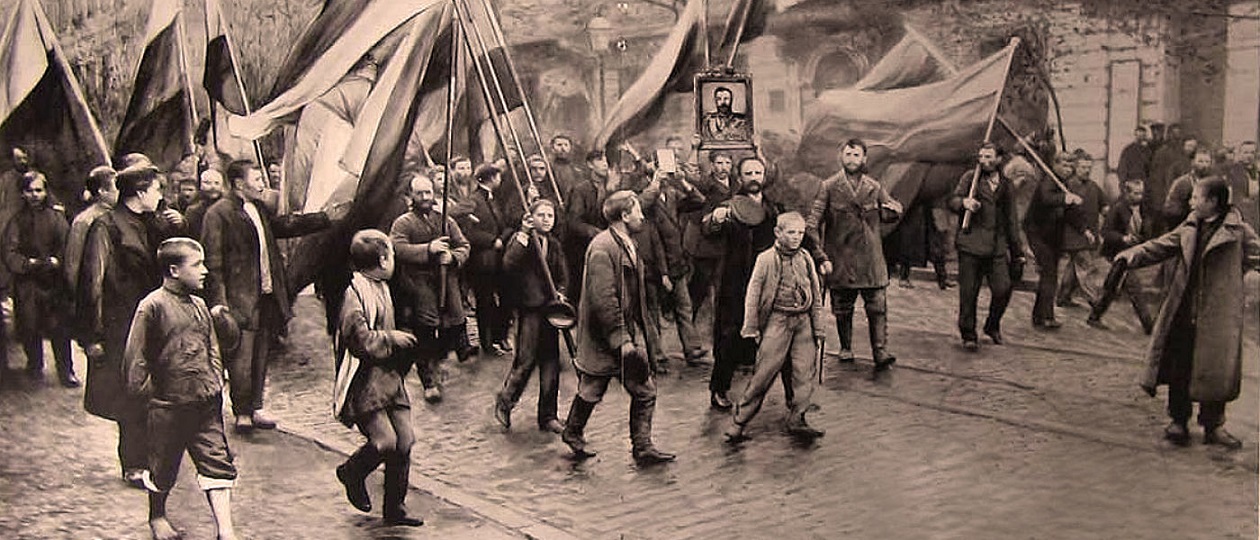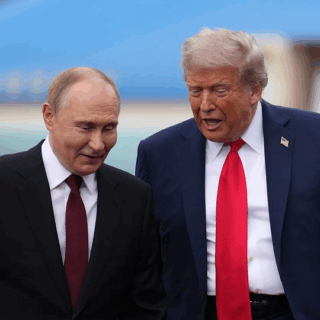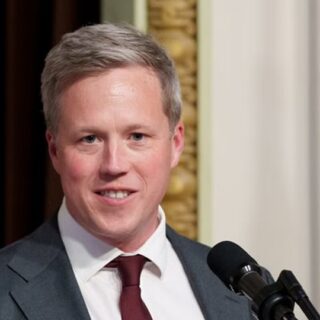
Far-right political terrorism occupies a virtually minimal place in the history of political terrorism in the Russian Empire between 1901-1911.
The overwhelming majority of the 17,000 people killed or wounded in terrorist attacks were victims of left-wing terrorist groups. However, terrorism and other acts of violence committed by the Black Hundreds [черносотенцы] — members of different far-right political parties and movements — deserve serious attention.
Members of fighting squads from the far-right Union of the Russian People [Союз русского народа] engaged in different types of violence during the Revolution of 1905-1907. Black Hundreds fighting squads helped police keep order during strikes and demonstrations, but they committed a few individual assassinations.
The two most spectacular terrorist acts were the assassinations of Kadet Duma deputies M.Ya.Gertsenshtein in June, 1906 and G.B.Iollos in March, 1907. Members of the fighting squads also planned assassinations of former Premier S.N.Witte, accused by many rightists of forcing Nicholas II to sign the October Manifesto, Prime Minister Petr Stolypin, and several other liberal deputies. Stolypin banned right-wing fighting squads in 1907.
In many ways, the Black Hundreds became the mirror image of their leftist opponents. Left-wing terrorists often saw themselves as engaged in single combat [единоборство] with the government. Black Hundred terrorists and their supporters saw themselves as engaged in single combat with the enemies of the tsar, the Russian Orthodox Church, and the Russian people.
In fact, many supporters of Black Hundred terrorism believed that their violence was justified because the government was no longer capable of defending itself after the Manifesto of October 17,1905 that granted political freedom and a State Duma. In their own way, the Black Hundreds constituted a right-wing revolutionary opposition to the government despite all their declarations of loyalty to Tsar Nicholas II.
The Black Hundreds not only began right-wing terrorism in Europe before World War One, but they also foreshadowed many tendencies in present-day Europe’s mass far-right populist parties.
Who Were the Black Hundreds?
It is extremely difficult to find a more complex and contradictory political phenomenon than the Russian Black Hundreds movement [черносотенство] among the different political tendencies in the Russian Empire.
The Black Hundreds movement is usually understood to mean an ideological tendency of different political parties, movements, and individuals on the extreme right of the political spectrum in Russia during the reign of Tsar Nicholas II. The major Black Hundreds organizations included the elite Russian Assembly [Русское собрание and the mass Union of the Russian People [Союз русского народа] and Russian People’s Union of Michael the Archangel [Русский народный союз имени Архангела Михаила. Leading members of the movements included A.I.Dubrovin, the first leader of the Union of the Russian People, and V.M.Purishkevich, one of the future murderers of Grigorii Rasputin. However, there were also leading luminaries of Russian culture who did not join Black Hundreds organizations, but whose views corresponded to the main tendencies of this far-right movement. For example, L.A.Tikhomirov, a former leader of the People’s Will, is often considered the main ideologist of the Black Hundreds movement even though he never belonged to any organization.
The Black Hundreds have generally received a negative evaluation from historians largely because of their antisemitism [hatred of Jews] and extreme Russian nationalism. They are often portrayed as the scum of Russian society. As Bertram Wolfe, an American political scientist and former Communist, wrote << <<Under the banner of Holy Russia was gathered a most unholy and variegated band: the backward, the degenerate, the brutalized, the bewildered, the enraged, the entrenched, the ruined: officers, landowners and gilded youth, demobilized old soldiers and personal serving men to whom loyalty to the master was the sum of all loyalties, criminals whose police record made them amenable to any instructions, ruined artisans and shopkeepers who were persuaded that the strikes and the eight-hour day were the cause of all their woes, hungry, degraded slum proletarians from the human scrapheap of the great cities, the more illiterate and credulous among the workingmen and peasantry.>>
However, several historians in post-Soviet Russia are showing that the Black Hundreds constituted a mass movement with mass appeal to a wide range of people. One receives the impression that the Black Hundreds were far more inclusive in mobilizing different strata of the population than their liberal and socialist opponents and European far-right parties in this period. The Black Hundreds granted membership in their organizations to women, Old Believers, Catholics, Lutherans, Muslims, and members of many national minorities. In fact, ethnic Russians were a minority in the Black Hundreds organizations in certain parts of the empire. They also recruited among nobles, officials, members of the clergy, workers, peasants, artisans, shopkeepers, merchants, professional people, men and women university students, secondary school students, etc. Despite their supposed hatred for modernization, the Black Hundreds used modern methods of political mobilization of wide strata of the population.
Because the Black Hundreds frequently used slogans such as <<Beat the Yids and save Russia!>> [жиды, a pejorative word for Jews], <<Russia for the Russians!>>, and <<Orthodoxy, Autocracy, Nationality! [Православие, самодержавие, народность], they have been accused of being fascists or protofascists. Already in 1925, the Soviet historian S.V.Liubosh prepared a publication about V.M.Purishkevich with the title <<The Russian fascist Vladimir Purishkevich>>. In 1929, another historian V.Zalezhskii emphasized that <<The Union of the Russian People, by its very nature, was the first fascist organization long before the appearance of Fascism in Europe.>> As will be pointed out in future articles, one cannot regard the Black Hundreds as fascists or even protofascists. Fascism, National Socialism, and related ideologies emerged in completely different circumstances in Europe after World War One and the Black Hundreds lacked the core elements of these ideologies. Undoubtedly, there were fascists and fascist groups among the anti-Communist White emigration, but one American historian made a rather unsuccessful attempt in demonstrating a supposed noteworthy contribution of some Russian emigrants in the formation of Nazi ideology.
What also makes the study of the Black Hundreds different is the fact that certain marginalized far-right groups in Russia today claim to be the descendants of the Black Hundreds and are trying to revive the movement. For example, the site <<The Black Hundreds>> [Черная Сотня] proclaims that is fighting for the restoration of an Orthodox autocratic monarch—in other words, restoration of the tsar and the Russian Orthodox Church as a state church. However, political and social conditions in the Russian Federation differ greatly from conditions in the Russian Empire. Today’s Neo-Black Hundreds are not linear descendants of the pre-1917 Black Hundreds and they can only engage in mimicry of the pre-revolutionary movement.
Furthermore, Neo-Black Hundreds only constitute a minority of the Russian nationalist far right in today’s Russia. The crowded playing field of far rightists includes Neo-Black Hundreds, monarchists, Russian nationalists, certain Russian Orthodox Church activists, Cossack movements — including descendants of pre-1917 Cossack hosts and those claiming to be Cossacks, paramilitary formations, neo-Nazis, neo-Fascists, neo-pagans, white supremacists, motorcycle gangs, soccer fans, skinheads, etc. Many of these groupings combine rightist and leftist ideologies.
Note that, unlike the Black Hundreds, many contemporary far-right Russian movements have close relationships with far-right European movements. Elements of continuity between the pre-revolutionary and contemporary far-rightists include the splintering of the right-wing camp, the impossibility of sharing power with the government, and the impossibility of carrying out a revolution from the right.
Despite the traditional negative historical treatment of the Black Hundreds and the attempt by many popular writers in Russia today to idealize them, several contemporary Russian historians are doing excellent work in exploring just how and why the Black Hundreds enjoyed such a mass appeal in contrast to European far-right movements in the period. The Union of the Russian People and other Black Hundreds organizations had about 400,000 members in 1907-1908, making them the biggest political movement in Russia. Although the figures may be inflated, the Black Hundreds set a European-wide record.
The Black Hundreds were a far-right Russian nationalist populist movement. One of their major issues included defining just what did it mean to be a Russian. Defining Russianness [русскость] determined who could be a member of the Russian nation and who could not be a member. Despite their insistence on Russian uniqueness, the Black Hundreds followed a common European tendency in drawing up criteria for membership in political and ethnic nations and fixing norms of behavior for members of the nation and determining criteria for excluding individuals and nations from the nation.
Citations
- Ruud, Charles A. and Sergei A. Stepanov. Fontanka 16: the tsar’s secret police. Montreal: McGill-Queen’s University Press, 1999. Русский перевод: Рууд, Чарльз А. и С.А.Степанов. Фонтанка 16: политический сыск при царях. Перевод с английского. Москва: Мысль, 1993.
- Рокки Т. Революция справа: российское черносотенство и его место в истории общеевропейских крайне правых партий и движений. Ч. I: Постановка вопросов к изучению черносотенства (Revolution from the right: the Russian black hundreds movement and its place in the history of European far right parties and movements. Part I: posing the questions for studying the Black Hundreds movement)// Историческая и социально-образовательная мысль. 2018. Т. 10. № 1. С. 47–61. https://cyberleninka.ru/article/n/revolyutsiya-sprava-rossiyskoe-chernosotenstvo-i-ego-mesto-v-istorii-obscheevropeyskih-krayne-pravyh-partiy-i-dvizheniy
- Wolfe B.D. Three who made a revolution. Rev. ed. New York: Dell Publishing Co., 1964.
- Rogger Hans. Was there a Russian Fascism? The Union of the Russian People. The Journal of Modern History, Vol. 36, No. 4 (Dec., 1964), pp. 398-415.
- Степанов С. А. Черная сотня. Что они сделали для величия России? (The Black Hundreds: what did they do for the greatness of Russia?) Москва: ЯУЗА ПРЕСС, 2013.
- Kellogg M. The Russian roots of Nazism: white emigres and the making of National Socialism, 1917-1945. Cambridge UK, New York: Cambridge University Press, 2005.
- http://www.sotnia.ru
- Chawryło, Katarzyna. Russian nationalists on the Kremlin’s policy in Ukraine. OSW (Centre for Eastern Studies). Commentary, No. 156, 24.12.2014. https://www.osw.waw.pl/en/publikacje/osw-commentary/2014-12-29/russian-nationalists-kremlins-policy-ukraine





